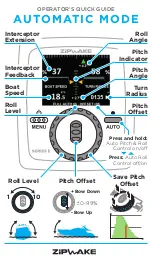
M.I. P/N 004-2163 Rev. C
27
sample to be injected evenly across the ends of the sample. However, the conductance
catheter method requires the use of two very small areas to inject the current. Thus, the
current density is much higher at these two points than at points half way between, where
the electrons are able to spread out. The current density will also be higher near the axis of
the current flow (the catheter) than in regions farther away since the electric field tends to
decrease with the cube of the distance.
In a single field configuration, the path of the current through the blood is not straight.
When graphed together, the electrons’ paths resemble the shape of an American football,
where the ends are narrow (the electrons must all pass through the electrodes) and the
central portion is expanded (the like charges of the electrodes cause them to repel each
other and spread out). Equipotential planes, drawn perpendicular to the electrical flow, are
not flat, except at a point half way between the excitation electrodes. Equipotential planes
closer to the electrodes tend to bow outward, away from the center plane. This effect is
more pronounced farther from the catheter, so measurements of smaller diameter volumes
can approximate a uniform field.
In a dual field configuration, the secondary current is injected to change the shape of the
electrical field so that it is more uniform. The polarity of the secondary current is the
opposite of that of the primary current and the amplitude is 30% of the primary current.
This straightens the equipotential lines and makes the electric field more uniform,
optimizing the electrical field to allow a more uniform measurement of volume in larger
hearts.
Resistivity – Rho Cuvette
Resistivity is a material property whereas resistance (and therefore conductance) is a
property of a sample or a structure. When measuring the conductance of the blood in the
ventricle, the reading is based on the electrical current passing through blood, a material
whose resistivity can change with temperature, hematocrit, and a number of other
parameters. Resistivity is used in Baan’s equation to relate conductance of the structure
(the blood in the ventricle) to the volume of the structure.
The MPVS
Ultra
rho cuvette measures resistivity using Baan’s equation, but in a form
where the equation has been solved for resistivity. The volume of blood in the cuvette is
known – it is that of a cylinder whose diameter is that of the well and whose length is the
distance between the voltage sensing electrodes. The current passed through the sample is
known since it is precisely calibrated during the manufacturing process. The voltage is
readily measured by the MPVS
Ultra
hardware. The resistivity can then be computed from
these known and measured values. (
α
is assumed to be 1.)
Effects of Temperature
The resistivity of blood is temperature dependent. The MPVS
Ultra
system does not adjust
the reading to correct for temperature. Instead, the rho cuvette measures the temperature of
the blood and the resistivity of the blood at the same time. (These are the values reported
in the Control Interface.) The user can correct for temperature if desired. Peer-reviewed
literature indicates that the resistivity of the blood varies by about 2% per degree C within
a few degrees of body temperature. This relationship is not linear, so the user should
attempt to make the measurement as quickly as possible after blood is drawn from the
animal. It is advisable to keep the rho cuvette well at approximately body temperature
before taking the measurement so that the well will not contribute to the cooling of the
blood sample.
Theor
y
of O
p
eration
Theor
y
of Operation
















































